Arctic Ocean sea ice increases after record low but remains far below long-term normal.
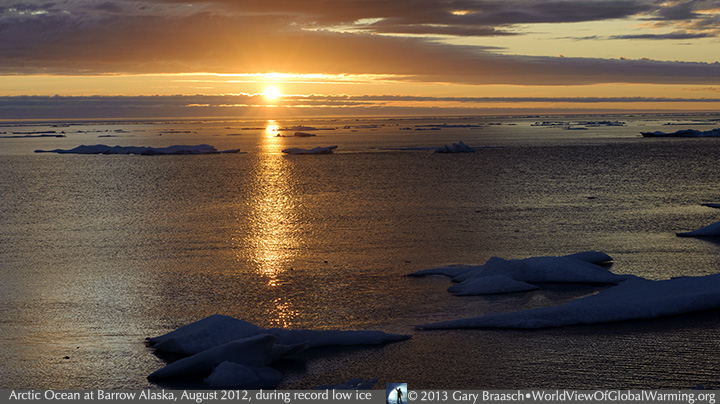
The floating ice which covers the Arctic Ocean, a major indicator of global temperatures and crucial factor in the world's weather and climate, reached its apparent yearly minimum on September 13, 2014, "substantially higher" than the record low of a year previously. The 2014 extent of ice is about equal to that of 2009, and is the sixth lowest in the 34 year satellite record. The National Snow and Ice Data Center (NSIDC) calculated that sea ice extent dropped to 5.10 million square kilometers (1.97 million square miles) in 2014, compared to 3.41million sq km (1.3 million sq mi) in the record-setting 2012. The 2014 area is about one-third the area of the Arctic Ocean, compared to summer low cover of about half the ocean in the late 70s and early 80s when yearly satellite measurements began.
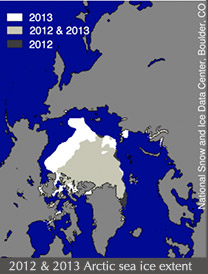
On September 16, 2012 the extent of Arctic sea ice reached its lowest point in the satellite record. The area of sea ice broke the 2007 record low by about 760,000 square kilometers (293,000 square miles). "This difference is larger than the size of the state of Texas," said the NSIDC.
The cold winter months re-freeze much of the ice, but over the same record period the thickness of this new ice has also been reduced. Multi-year ice, which resists melting more than new ice, has been decreasing across the Arctic, also. "The character of the ice is fundamentally different: It's thinner, more broken up, and thus more susceptible to melt completely," NASA glaciologist Walt Meier said. "This year, the cool temperatures saved more of the ice. However, the fact that as much of the ice melted as it did is an indication of how much the ice cover had changed. If we had this weather with the sea ice of 20 years ago, we would have had an above-normal extent this year."
The new record low in 2012 and continuing below normal cover in 2014 comes as confirmation of scientific projections of the imminent loss of Arctic Ocean sea ice in summer months due to climate warming. The effects of a far more open Arctic ocean are already well documented, including warmer sea temperatures, less reflectance of solar heat from the ice, changes to Arctic ocean and land ecosystems including severe threats to polar bears, walrus and seabirds, alterations in weather and storm systems in the Northern Hemisphere, increased thawing of permafrost with more releases of CO2 and methane, and serious problems of health, subsistence and living for natives of the North.

Warming Winds, Rising Tides: Arctic
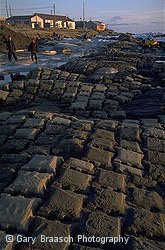
Sea level rise also affects the Arctic, where it is frequently combines with permafrost thaw to create severe erosion. The native village of Shismaref Alaska, a village of about 590 Inupiats perched on a sandy barrier island on the NW shore of Seward Peninsula, has failed to halt the rising Bering Sea. Shore erosion of the narrow spit has been severe since the 1950s, and protective armor and wire gabions have been ineffective. The town faces a decision to move inland, away from this traditional site. Townspeople voted in 2002 to move their village to higher, more protected ground away from the ocean.
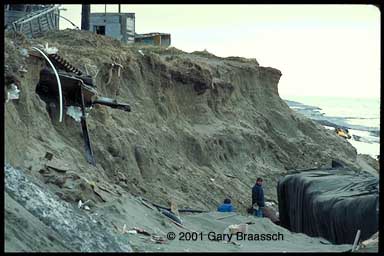
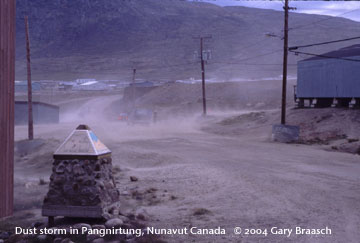
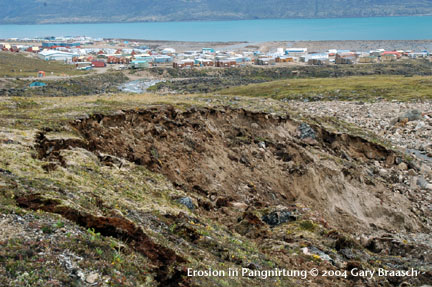
On Baffin Island, across from Greenland in Nunavut, Canada, the loss of ice and permafrost is affecting daily life of native Inuits. Winter hunting and fishing is limited severely by loss of ice. In summer, permafrost is thawing, creating more erosion, and ice that once covered the surrounding mountains year long is nearly all melted. Elders in the village of Pangnirtung report that winds have shifted and winters are getting much shorter -- observations that weather records confirm.
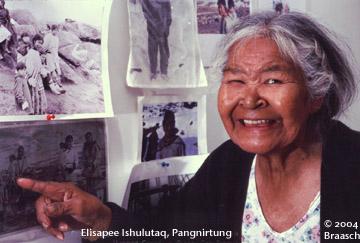
Elisapee Ishulutaq, a 78 year old artist with a spry and radiant smile, was born in an outpost camp when most natives here were nomadic. They were dog sledding as late as July, she remembers, more than two months later than snow and ice breaks up now. "All the mountains were covered with glaciers." she said. "There isn't any deep snow anymore." Elisapee pointed to her younger self in black and white photos on her living room wall. She said there were stories in her childhood about a warmer future. "It was foretold by the elders that sometime the north would warm up and south would cool down."
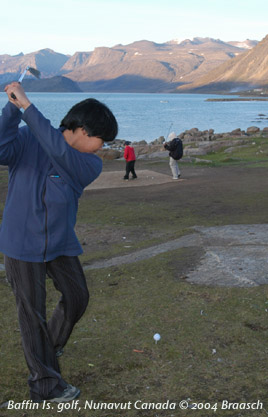
Kids in Pangnirtung have taken to golf in the increasingly dry and dusty summer months. This contrasts with Elders' memories and old photographs of villagers clad in warm skins and fir in mid-summer, playing more traditional games like tug of war while around them the mountains were snowcapped
Photographs from the World View of Global Warming are available for license to publications needing science photography, environmental groups and agencies, and other uses. Stock photography and assignments available.
Use of photographs in any manner, in part or whole, without permission is prohibited by US copyright law. These photographs are registered with the US Copyright Office and are not in the Public Domain.
COPYRIGHT NOTICE:
Photography and text Copyright © 2005 - 2017 (and before) Gary Braasch All rights reserved. Use of photographs in any manner without permission is prohibited by US copyright law. Photography is available for license to publications and other uses. Please contact requestinformation@worldviewofglobalwarming.org. View more of Gary Braasch's photography here.


